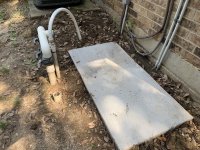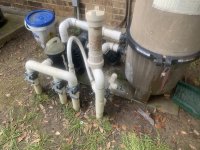I have never really done much with PVC. Everyone I ask just tells me "it's easy", but some of the only helpful advice I've gotten is "use the least amount of elbows as possible". But I am very much designing a flow setup all by myself and I would really like to do it better than the people prior. The Swimming Pool Plumbing Repair Page is helpful...but leaves something to be desired.
So I think I have all the tools and equipment, just need to buy PVC...straight pipe, unions, and elbows (and maybe a valve).
I am doing most of the setup with 2" Schedule 40 PVC as before, the only part that might not be 2" will be at an end where I install a garden hose connector so I can drain the pool (as done prior).
My plumbing equipment to be connected:
Previous Setup
So I think I have all the tools and equipment, just need to buy PVC...straight pipe, unions, and elbows (and maybe a valve).
I am doing most of the setup with 2" Schedule 40 PVC as before, the only part that might not be 2" will be at an end where I install a garden hose connector so I can drain the pool (as done prior).
My plumbing equipment to be connected:
Pentair Challenger High Pressure Pump
Polaris PB4-60 Booster Pump
Hayward Swimclear CX020 (I believe X = 3)
Hayward W3AQR15 Salt Generator
Blue-White R320 Flow Meter
My Pipe Tools
PVC Cutter (up to 2 1/2")
PVC Deburring Tool (up to 3.5")
PVC Pipe Saver (1.5" and 2")
My Pipe Expendables
Weld-On P70 Primer
Weld-On 724 CPVC
Magic Lube
Teflon Tape
Current Setup
Fortunately all the underground pipes are good, and the above ground pipes can be connected to. As pictured, I have an empty 2x4 poured concrete slab (foam reinforced) next to the 3-to-1 intake, main 2" return, and smaller booster pump return (will not be reusing the hose or connector).


Previous Setup
Previously there was a tab feeder (no chlorinator), no flow gauge, and no way to bypass the booster pump. Additionally, no unions were used on the Pentair pump...making repairs troublesome. (The whole thing leaked and was falling apart btw). Otherwise, the setup will be very similar to before (pictured; booster pump is manually bypassed here). Will be reusing the Jandy valves (via pipe saver), as well as buying a new three way for the booster pump.


So what are my questions??
I don't know what I don't know. Is there anything else I should be adding to my setup?
I am most concerned that my Pentair Pump volute will no longer line up perfectly with the 3-to-1 intake...what is the best route here if so?
For the chlorinator, should I install it in a parallel pipe setup so as to allow for bypassing (as well as being able to properly balance the water before putting in operation)?
Is there any magic to properly measuring the pipes and positioning equipment? What about installing unions?
Any common mistakes or tips for success?



